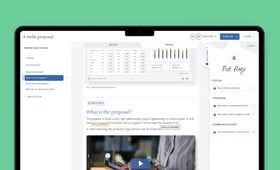“Meetings are where minutes are taken and hours are wasted.”
This quote, often attributed to fictional space commander Captain Kirk, hits home. A 2022 University of North Carolina study found that a third of meetings are unnecessary.
Worse still, they’re expensive. In large companies, meetings cost over $100 million a year. That’s why many organizations are cutting recurring meetings, capping durations at 30–45 minutes, and introducing “no-meeting” days to ease the load.
Sadly, those tactics don’t apply to our most expensive and essential get-togethers: board meetings.
The board is not day-to-day, but from great material, 4–5 meetings per year, and various discussions they must mitigate, protect, and anticipate risk before it starts to affect the company.”
Chris Perry, President, Broadridge Financial Solutions
Joint research by Board Intelligence and the Chartered Governance Institute UK & Ireland shows that board and committee meetings at large companies have cost around $400,000 per year since 2020.
Yet few leaders believe they’re getting value. In a recent Board Intelligence survey, 91% of business leaders said their board needed to spend less time in the weeds and focus more on big-picture goals.
So, how can you make better use of the board’s time and get more value from each meeting?
How do you plan effective board meeting agendas?
Two simple tools can help governance teams, chairs, and CEOs plan effective board meeting agendas and annual calendars.
The first is the “jar of life”, which encourages a structured and strategic approach to time.
Imagine the board’s time as an empty jar. Like the jar, time is limited. So what goes in first?
What goes into the jar, board topics, usually falls into three groups:
- Rocks: Big strategic discussions, major decisions, and planned deep dives. These are large, inflexible and hard to move.
- Sand: Routine items like performance updates, compliance, and admin. Small and administrative, but plentiful.
- Pebbles: Unexpected, hard to plan for ad hoc or urgent items, like a director’s last-minute request or a sudden IT outage that causes downtime at the data center.
Most people fill the jar with sand first, then pebbles. Unfortunately, that leaves little space for rocks. This crowds out the strategic items that matter most.

To fix this, reverse the order: add the rocks first. Then add sand — shaking the jar to fill gaps — and be ruthless. Delegate, reduce frequency, or handle low-priority items offline.
That leaves room for pebbles without sacrificing what matters. Your agenda will then reflect your organization’s priorities, not just its admin list.
How do you work out what the board’s priority conversations are?
Planning is only half the battle. You also need to know what the priorities (or “rocks”) actually are.
That’s easier said than done. Boards often face long lists of top priorities. One director once joked that his board needed a horizontal agenda to fit its 20 “number one” priorities.
This is where the second tool helps: the Six Conversations model. It’s a simple way to shape meeting agendas and calendars around mission-critical topics that help the organization deliver on its vision and goals.
The model groups the board’s work (or conversations) into six categories across three main areas: strategy, performance, and governance. Each area supports the board’s two core roles at any given time:
- Steering: Helping the organization set direction and reach long-term goals.
- Supervising: Monitoring performance and ensuring accountability.
Using this model, boards can define the key question(s) they must address in each area for the year ahead. These questions form the “rocks” around which the calendar should be built.
Once priorities are clear, the board can decide how often and for how long to discuss them. It can also trim the list by delegating some topics to management or committees to prevent overcrowding.
Besides shaping agendas and calendars, the Six Conversations model gives governance teams a clear framework to assess whether the board is fulfilling its duties and covering what it should, and in the right balance.
That matters because most boards lean heavily toward supervision and performance (“Will we hit our targets?”), while strategy often gets pushed aside.
Board Intelligence research found that only 16% of directors felt they spent too much time on performance, while 44% felt short-changed by the amount of time they spent on strategy.

Using this model, boards can define the key question(s) they must address in each area for the year ahead. These questions form the “rocks” around which the calendar should be built.
Once priorities are clear, the board can decide how often and for how long to discuss them. It can also trim the list by delegating some topics to management or committees to prevent overcrowding.
Besides shaping agendas and calendars, the Six Conversations model gives governance teams a clear framework to assess whether the board is fulfilling its duties and covering what it should, and in the right balance.
That matters because most boards lean heavily toward supervision and performance (“Will we hit our targets?”), while strategy often gets pushed aside.
Board Intelligence research found that only 16% of directors felt they spent too much time on performance, while 44% felt short-changed by the amount of time they spent on strategy.
Translating our priorities to agendas gives the board and me confidence we’ll use our time well.”
John Pettigrew, CEO, National Grid
How do you turn board agenda planning theory into practice?
Start by stepping back. Review where the board has been spending its time. What’s missing? What needs to change?
Next, run a structured consultation led by the chair and company secretary. Involve the board and executive team to define the board’s focus and key priorities.
The Six Conversations model is a helpful guide here. You can also work with a team of experts to facilitate a board priorities and agenda planning exercise that results in a focused board calendar of robust, yet flexible, meeting agendas.
Once your priorities and process are clear, it’s time to translate this into an operational process.
Most boards plan agendas in advance, but things often change. Tracking moving pieces across spreadsheets and documents can be a nightmare.
That’s where tech can help.
Board Intelligence’s Agenda Planner tool makes forward-planning easy. From a single view, you can plan your forward calendar and manage last-minute changes with a simple “drag and drop” feature. You can also track where your board spends its time and proactively course-correct, so you can more easily evidence compliance and ensure that it’s your board’s priorities, not convention, driving your organization forward.

Work with Board Intelligence’s team of board effectiveness experts to set your board up to succeed.
Find out more


